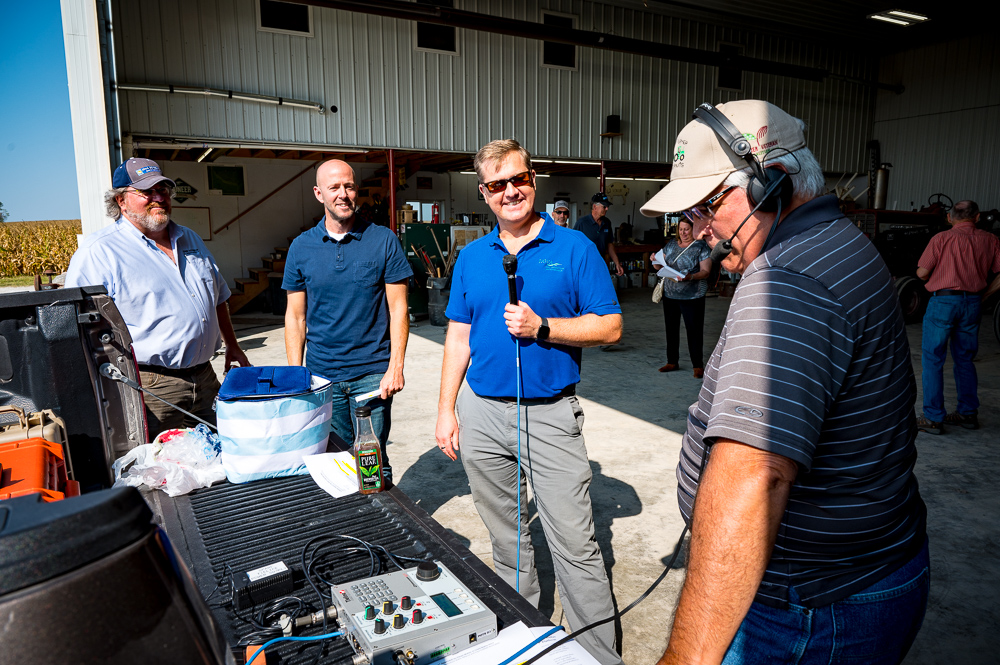
Bob Quinn (right) interviews Roger Wolf, Jonathan Gano and Sean McMahon during a Clean Water in Iowa Starts Here event in Perry. (Photo: Joseph L. Murphy/Iowa Soybean Association)
Statewide program highlights water quality efforts
September 17, 2020
The Clean Water in Iowa Starts Here campaign made a stop at a little watershed that could soon see significant conservation results.
Leaders from the Iowa Soybean Association (ISA), Iowa Agriculture Water Alliance (IAWA) and the City of Des Moines were on hand in the Swan Lake Branch watershed, near Perry, to celebrate a saturated buffer, two bioreactors and other conservation practices that are making water cleaner downstream.
A watershed plan written by the ISA and other partners has fostered collaboration with partners like Des Moines Public Works through a Sponsored Partner Project funded by Iowa's State Revolving Fund according to Roger Wolf, the Director of Innovation & Integrated Solutions with the Research Center for Farming Innovation.
"The Iowa Finance Authority makes an investment in this," Wolf said. "Because of that transaction, we're able to capture some of the money with the City of Des Moines and invest that with farmers to pay for practices in this watershed."
Tom Vincent, a farmer and ISA Director, hosted yesterday's event. He has two large bioreactors and he installed a saturated buffer with the help of his landlord. During the event, Vincent's conservation efforts were highlighted as examples of how conservation drainage systems can improve the landscape while allowing farmers to remain profitable while improving water quality.
"I think we as farmers need to be doing our parts to have a positive influence on the water that goes downstream," Vincent said.
The City of Des Moines is working in the Swan Lake Branch watershed, an area that is roughly 25 square miles, to help mitigate flood waters before it reaches city limits.
"Out of 15,000 square miles, you have to start somewhere," Jonathan Gano, Director of Public Works, City of Des Moines said. "We're interested in subsidizing practices that don't have yield benefits because there's little incentive for them (farmers) to do so. We're willing to step in and fill that gap."
Vincent decided to make changes on his farm before being faced with the possibility of regulation in the future. In 2017 he was a part of an Iowa delegation that attended the One Water Summit in New Orleans. That event helped him realize the importance of urban-rural partnerships and the philosophy of One Water.
The One Water platform was started by the US Water Alliance to engage with partners across all water sectors. The US Water Alliance promotes water equity through One Water programs, including the national One Water Summit.
Individuals and delegations attend the annual summit to discuss and plan out collaborative approaches to water quantity, quality, and equity issues. Iowa has led a delegation the past four summits and sought innovative ways to bring the inclusive and cooperative ethos of One Water back to the local and state level.
"Iowa is leading the nation in this," Wolf said. "I like to say that we are operationalizing the One Water approach."
Gano and the Des Moines Public Works will be investing substantial funding to install bioreactors and saturated buffers elsewhere in the Swan Lake Branch watershed in the near future through the Sponsored Project.
"We won't be successful in implementing the Iowa Nutrient Reduction Strategy if we don't have strong urban-rural partnerships in Iowa," observed Sean McMahon, Executive Director of the IAWA. "We are thankful to have so many strong, committed urban partners like the City of Des Moines Department of Public Works, the Great Outdoors Foundation, and the City of Cedar Rapids. They are investing in our projects and working shoulder-to-shoulder with us to improve water quality and reduce flood risk."
Bob Quinn (left) visits with Sean McMahon and Tom Vincent (right). (Photo: Joseph L. Murphy/Iowa Soybean Association)
Roger Wolf, Iowa Soybean Association, describes the benefits of upstream conservation methods during a Clean Water in Iowa Starts Here Big Show interview. (Photo: Joseph L. Murphy/Iowa Soybean Association)
The Big Show on WHO Radio has made six stops on their Clean Water in Iowa Starts Here campaign. (Photo: Joseph L. Murphy/Iowa Soybean Association)
Tom Vincent, ISA director and farmer, answers a question during an interview. (Photo: Joseph L. Murphy/Iowa Soybean Association)
From left: Roger Wolf, Iowa Soybean Association; Jonathan Gano, Des Moines Public Works; Sean McMahon, Iowa Agriculture Water Alliance. (Photo: Joseph L. Murphy/Iowa Soybean Association)
Jonathan Gano, City of Des Moines, is interviewd by Bob Quinn of the Big Show. (Photo: Joseph L. Murphy/Iowa Soybean Association)
Sean McMahon talks about the benefits of conservation measures during an interview on the Big Show. (Photo: Joseph L. Murphy/Iowa Soybean Association)
Sean McMahon, Tom Vincent and Roger Winterhoff at a saturated buffer site. (Photo: Joseph L. Murphy/Iowa Soybean Association)
Back